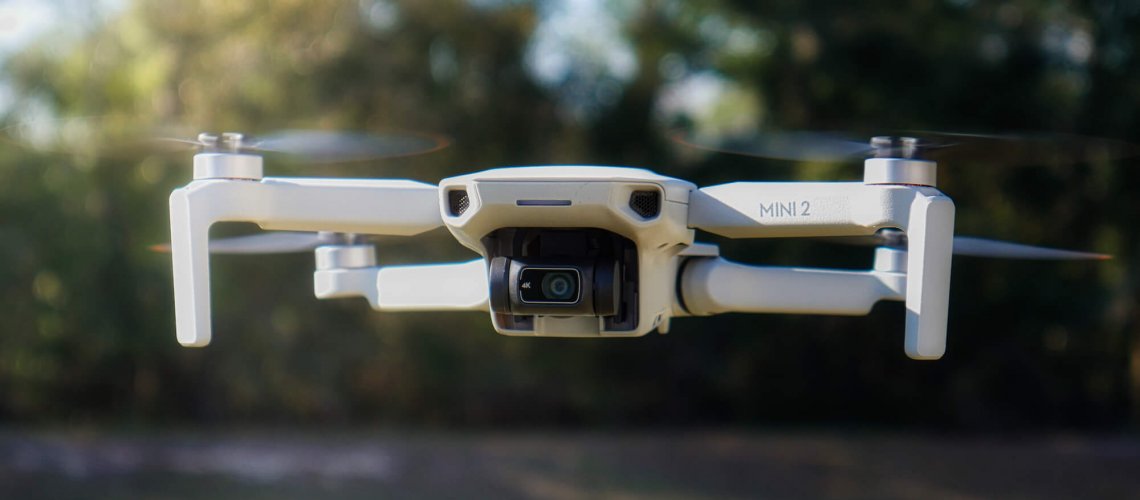4 Years and 7 blog posts ago, I wrote about getting my FAA issued UAS (Unmanned Aircraft System) Remote Pilot’s license. I also mentioned some “trajectories have been altered”. There is never a promise in my blog posts to blog more. Only hope that I can. The trajectories over the past 4 years have been many, so it’s not like I don’t have a lot to talk about. I just need to put myself in front of this “Edit Post” screen and do it.
So let me start by summarizing my droning journey and catch you up on the last 4 years. However, first I need to go back to 2014 and my initial experience with a drone. It began by following the leaps in technology regarding aerial video and photography, notably the shrinking of the size of drones. As my University of Mary Washington colleagues will remember (June of 2014), we experimented with a DJI Phantom drone which was purchased with funds for a new building that was going to be the experimental hub of DTLT – the Convergence Center. One thing I vividly remember about those test flights was that we were all paranoid about a flyaway drone, so our initial flights were tethered – we used a long ethernet cable. I wasn’t initially hooked by drones. They were relatively small at the time, but they were still a little unwieldy. However, the seed was planted.
After an exhausting Fall of 2014, dealing with the inevitable issues of opening a new building, my family took a bit of a holiday vacation in… Northeast Florida (of all places, right?). We visited Jacksonville (including the University of North Florida campus), St. Augustine, and Amelia Island, and while it was December, temps were in the mid-60’s to lower 70’s. Well, you know the rest of that story because as I write this I have been working at UNF for 5+ years. I started at UNF in September of 2015, and continued to experiment with new gadgets.
In late 2016 I started using a DJI Osmo Mobile “gimbal” (image stabilizer) with my iPhone. It was great at timelapse video because not only would it take the photos (with the included app), but it could also pan while it recorded. Here’s an example, without the panning.
Around the same time I had seen an announcement for the Jacksonville Drone Expo at a local community college. It was there that I saw the cutest little drone, the DJI Mavic Pro. I started thinking of the shots (photos, yes, but mostly video) that I could get with a compact flying device. From there I took a recommended course that was preparation for passing what was, and is still known as the FAA “Part 107” test. I was becoming hooked on this whole drone thing. I purchased one of those (expensive) Mavic Pro’s for myself. I passed my UAG (Unmanned Aircraft General – aka Part 107) test on March 2, 2017. I was now ready to make beautiful aerial art!
Then reality set in – in more ways than one. My family life changed (don’t know if I’ll ever blog about THAT) and I also realized that flying a drone wasn’t that simple. Well, the flying part was great, it’s just WHERE you were legally allowed to fly was a bit murky. I kind of knew from the beginning that there were several legal issues around flying drones (ones that a lot of people blatantly disregarded) and they’ve been well documented over the years. At the time, the system, if you can call it that, required you to get permission to fly in “controlled” airspace. You see, I live just under two miles from an airport. It’s not the main Jacksonville Airport, but a smaller, “Executive” airport. However, the airspace surrounding the airport is “restricted” and living within a 5 mile radius required me to get permission to fly a drone at my own house! Those who know me will understand that I did things by the book and that was an impediment to flying. There was talk of a new system being built, but it was still in the planning/beta stages. The system at the time was complex and sometimes could take up to 90 days to give you approval. Not conducive to taking out the drone for a quick flight.
So my Mavic Pro sat in a closet. I went to a local drone user group meeting, but that became frustrating because it was mostly professionals who used drones in emergency situations, or inspected towers, or maintained large cargo ships. I was a bit lost in a confusing, new world. I was a bit soured on drones. Over time, drones kept getting smaller and smaller.
I lied. I said I would catch you up on the last 4 years. President Trump, Global Pandemic, yada. yada. yada. Let’s skip to about 5 months ago. DJI launched the Mini 2, an update to the 249 gram drone (the DJI Mavic Mini) that was an instant success (for all the wrong reasons – more about that later). Also, something called the LAANC (“lance”) system was becoming something that included all of the major airports, as well as the minor ones. What LAANC does is give approval immediately for your restricted airspace flight. I use an app on my iPhone (there’s also a Google Play version) called Kittyhawk (UPDATE 6-4-21 – The app is now called “Aloft”) but you can also use the website to get information airspace anywhere in the U.S. – B4UFLY. This app will pinpoint where you are and tell you about controlled airspace. After registering, you can get immediate approval for either a “recreational” or a commercial (under Part 107 certification) flight. It’s still a bit confusing because I have a DJI drone and I live in an area with overlapping controlled airspace. DJI has something called GeoZone’s and you need to get separate authorization just for you to take off with your drone. A bit frustrating when there is a two step process when you should only need one. There is talk of integrating/simplifying this, but it can cause you to curse and swear, as I did recently when DJI changed their system and required me to enter more detailed information just to get that unlock code.
But it’s better now, and I’m having fun with my new drone, something that it wasn’t under the old system.
And, speaking of new systems, there is a new way to stay current with your Part 107 certification (now known as “recurrent” training). You see, before April 6, 2021, you had to take another exam to renew your Part 107 license. You had to register at an official testing center (mine is at that airport two miles away). The exams are $160. I didn’t want to pay that again. Well, I would have if I needed to, but I decided to wait for the new testing system (so many systems) to go into effect. As of April 10, 2021, I am “current” and will be for 2 years.
Now, if I didn’t want to go through all the certification, I could fly as a recreational pilot, but that limits what I can do with my drone. If I wanted to do real estate photography, or inspect a roof (and get paid for it), or use any of my footage commercially, I would need to have a commercial license. Again, Part 107 certification. The FAA website is still catching up to its new rules, but they have basic information for getting a drone pilot license. If you already hold a Part 107 certificate and you need to renew it (every 2 years), you can enroll in the “recurrent training course”. You’ll need to create an account on the FAA Safety website.
Now, about that drone of yours. You also need to register it with the FAA. Unless… it weighs under 250 grams AND you will only fly recreationally (not make any money or get compensation). This brings me to the so called selling point of the DJI Mini 2. It weighs 249 grams, so you don’t have to register it if you fly recreationally, which is nice, I guess. How much do you save? $5. Really, just register your drone. You’re likely going to have to anyway, unless you have a true “toy” drone. Why? Because something called Remote ID is coming in 2+ years (September 2023 as of right now) . As it reads right now, it’s a bit of a mess, and many moving parts need to get sorted. They will give drone manufacturers time to ramp up with the technology (September 2022), then the requirements for pilots to use a Remote ID drone will take effect a year later (2023). What that means is you will need a drone with Remote ID broadcasting built-in, or an add-on module. If you choose neither, you can fly in a designated zone called a FRIA or FAA-Recognized Identification Area (PDF). All of these rules are being hotly debated, so I’ll leave that topic for you to research.
OK. Well that should at least sort of catch you up a bit. If you feel cheated, I’m sorry. You read all the way up to this point and I did give you a lot. Until the next post…


8 Responses
Hey Andy! Eager to see what your flying video skills create.
Having recently moved to a country property I have found an interest in droning as well, to document the land and what we hope to do here. If you have any recommendations for a good beginner (cheap for practice) drone might be. One day I can maybe be like Andy…
Alan, I’m eager too. The next step is to do some flights on the UNF campus. Even more regulations, but I think I have something worked out. There’ll be a website for that too!
As for drone recommendations, I highly recommend the Mini 2. Very compact but handles really well and is so stable. It is about $500 with accessories. There’s also the fascinating FPV drone world, where you can build your own. I was so paranoid about even posting my flights to YouTube and crossing the “commercial” threshold. I will get some footage up in the next couple of weeks. More to come.
Thanks for the recommendation as the numbers of options and mixed reviews was boggling. I ordered a Mini 2 as my own birthday present. To be continued, but many thanks!
Welcome to the club! I see a new identity for you – CogDogDrone
Floor hockey at SUCO please?! Nice to see you doing so well bud!
WOW! A blast from the past, Josh. As I’m watching the hockey playoffs I was literally thinking of those days in Oneonta. It was good exercise in those cold winter months. Hope you’re doing well, and I do also miss 43 Elm St. – https://goo.gl/maps/wtz89KPNhe9cqXdx9